Limited outdoor space doesn’t have to limit creativity. When every square foot counts, smart garden design becomes more about intention than size. Whether you’re working with a tiny balcony, narrow side yard, or compact backyard, the right layout and elements can make it feel expansive and functional. From space-saving planters to multi-purpose seating zones, these small garden ideas solve common layout frustrations while adding charm and usability. If you’ve been unsure how to make the most of your limited space, this guide offers practical inspiration that feels achievable. It’s time to turn your small outdoor area into something genuinely impressive and personal.
Curved Brick‑Edged Corner Garden Nook

Tucked into a quiet corner, a curved brick-edged nook adds both charm and structure to a small garden. This design effortlessly merges hardscape with nature, offering a warm-toned, grounded perimeter for planting. The curved layout breaks up rigid lines, guiding the eye gently while softening tight spaces. Lining the inner edge with perennial herbs or low flowering shrubs can create seasonal bursts of color and fragrance. For seating, a single wrought iron chair or teak bench allows for private reflection or a morning coffee spot. Brick provides durability and visual texture, and its earthy hue complements surrounding greenery. Topping the soil bed with pebbles or mulch can reduce maintenance while preserving moisture. This compact feature becomes a sanctuary when combined with solar lanterns or a trailing vine. Curved elements encourage flow, making even a modest backyard feel thoughtfully planned and visually engaging. It’s a timeless solution for homeowners looking to add layered interest without overpowering the layout. Brick’s tactile quality and organic finish also offer excellent contrast against leafy textures. When executed with balance, this curved garden nook becomes more than just a landscaping accent—it serves as a restful retreat designed to maximize small-space potential with timeless garden design sensibilities.
Corner Seating with High‑Back Benches
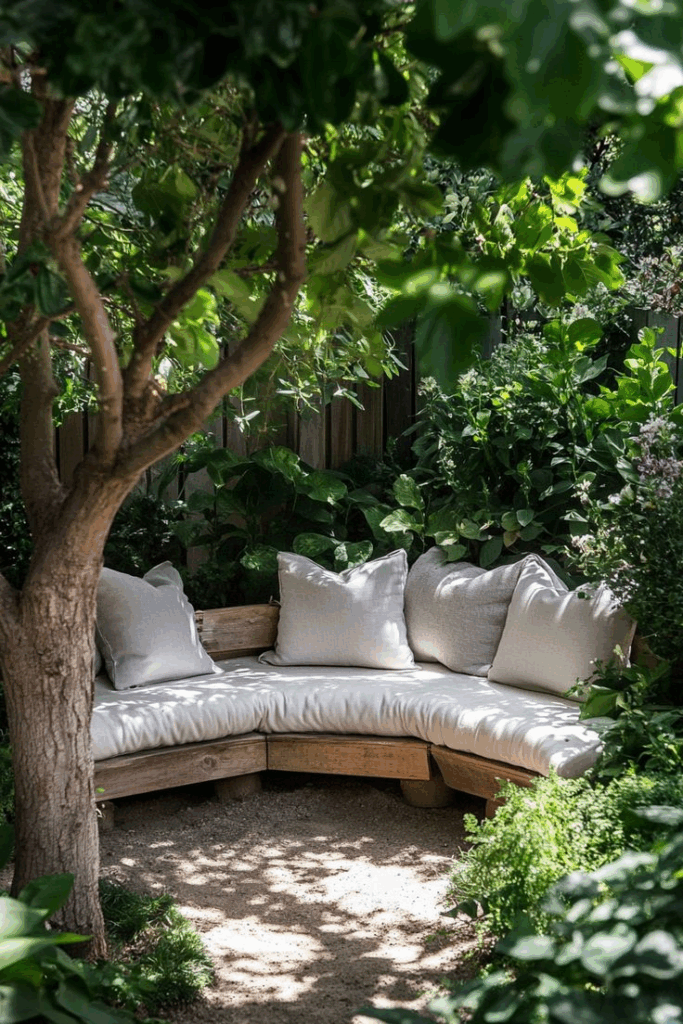
Privacy and comfort can be reimagined when high-back benches define a corner seating area. By visually anchoring the space, these tall-backed seats create a subtle barrier from neighboring views while offering ergonomic support. Ideal for reading, chatting, or simply resting, they encourage visitors to pause without feeling exposed. When paired with potted plants or vertical planters behind, the seating nook gains a lush, enclosed ambiance. Wood finishes like cedar or teak add warmth and weather resistance, while metal variants offer a sleeker, modern edge. For compact gardens, positioning these benches diagonally can utilize unused space efficiently. Consider cushions in muted or earthy tones to soften the visual bulk and tie into surrounding garden palettes. Lighting can be subtly integrated with stake lights or string bulbs overhead for an inviting glow in the evening. The corner bench layout also makes room for a small side table, perfect for a drink or garden journal. When thoughtfully placed, this arrangement transforms an underused corner into a functional and inviting spot. Rather than clutter, it promotes structure and serenity, balancing aesthetics with purposeful use. It’s a reliable solution for homeowners seeking to introduce restful elements in tight landscapes.
Vertical Herb & Climber Walls
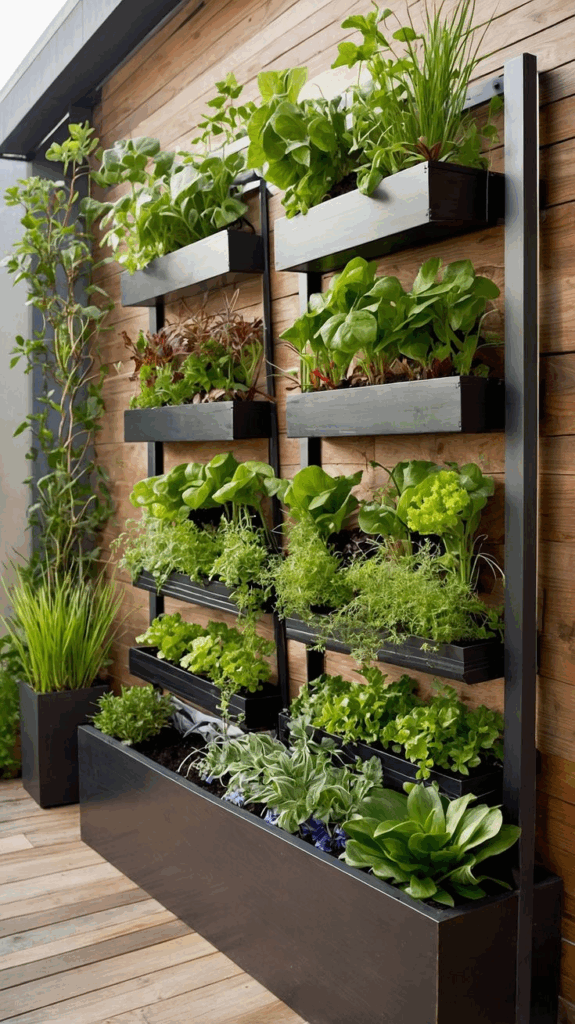
Walls can work harder when utilized vertically with herb and climber installations. For compact gardens, vertical green layers offer a high-yield, low-footprint solution. Trellises, wall planters, and hanging pockets can host basil, thyme, mint, or even strawberries, creating both utility and beauty. Vining plants like jasmine or clematis bring vertical movement and seasonal blooms, while also acting as natural screens. This setup helps maximize growing area in limited square footage, especially in urban or balcony gardens. Wood slats, wire grids, or recycled pallets can serve as affordable frameworks for climbers. Including drip irrigation systems or self-watering pots ensures consistent hydration without constant maintenance. These walls are not only space-efficient but also reduce heat by adding green insulation to bare surfaces. Modular installations allow seasonal swapping—grow lettuce in spring, then beans by midsummer. Combining edibles with florals can turn a plain wall into a lively canvas of texture and color. For renters or small-space dwellers, portable racks offer the flexibility to relocate as needed. Ultimately, vertical gardens make efficient use of overlooked areas while promoting sustainable living. They are a smart blend of form and function for anyone seeking to expand their garden footprint without sacrificing space or design integrity.
Mirror Panel to Visually Expand Space
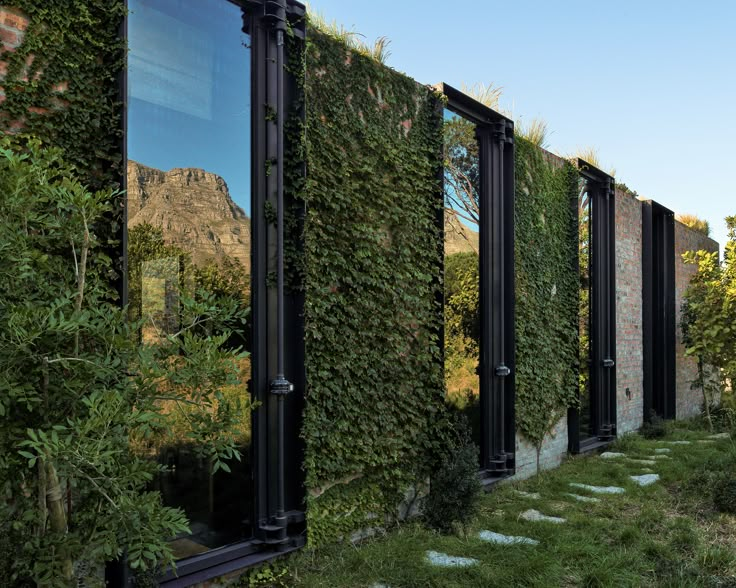
Visual illusions can make a small garden feel expansive, and mirror panels offer one of the simplest yet most transformative tricks. Strategically placing mirrors along shaded or narrow walls doubles the perception of space and light. This design choice is especially useful in courtyard gardens or balcony plots that lack depth or natural sunlight. Framed mirrors that mimic window panes add architectural interest while bouncing light onto plants that need it most. For safety and longevity, outdoor-grade acrylic mirrors are ideal, resisting weather while providing high reflectivity. Positioning is key—opposite greenery or focal features ensures a realistic and seamless reflection. Avoid placing mirrors where they might concentrate heat or blind the viewer; shaded spots work best. To enhance the visual effect, surround the mirror with trailing vines or wall-mounted planters. This integration softens the mirror’s edge and allows it to blend into the scenery. The result is not just decorative but functional, turning dead zones into visually rich areas. By playing with perspective, mirrors introduce a sophisticated solution to cramped layouts. When used thoughtfully, this tool balances style with spatial enhancement, making any petite garden feel more open, luminous, and thoughtfully styled without altering the physical footprint.
Terraced Stepping‑Stone Pathways
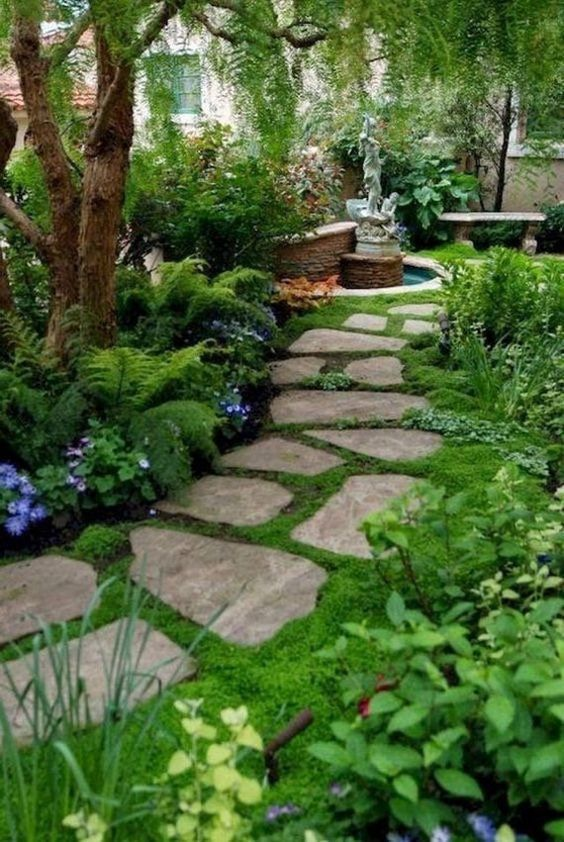
Tiers of natural stone arranged in a meandering path can breathe new life into sloped or uneven garden terrain. These terraced stepping-stone pathways guide movement while subtly framing planting zones and elevation shifts. Selecting stones with varied textures—such as sandstone, slate, or limestone—adds depth and character to the design. Instead of rigid grids, soft curves allow for a more organic integration with the landscape. Spacing stones to accommodate low-growing moss or creeping thyme enhances visual appeal while encouraging biodiversity. A well-graded slope prevents water pooling and promotes healthy drainage, reducing erosion risks. This setup also improves accessibility across tricky slopes, making it easier to navigate while offering visual rhythm. Between steps, integrate native grasses or flowering borders to tie the pathway into the broader landscape. Solar ground lights placed alongside the edges create a safe and glowing guide after dark. Terracing sections of a garden with these pathways makes every level feel intentional rather than leftover. For small spaces, even modest slopes benefit from defined transitions that give order to the layout. This pathway solution combines structure, sustainability, and softness, perfectly suited for homeowners looking to maximize function in gardens with topographical challenges.
Low‑Level Modular Seating with Hidden Storage
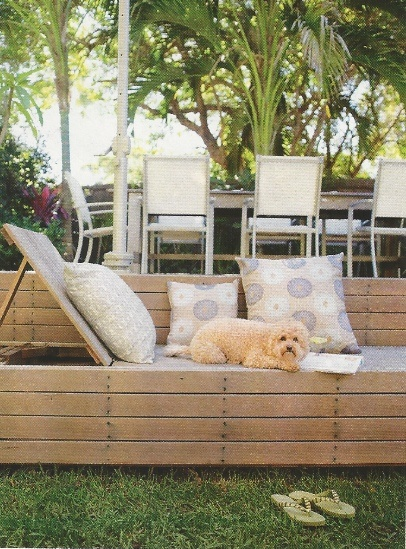
When floor space is limited, low-level modular seating offers a dynamic solution that fuses comfort with clever storage. These seat units double as containers, tucking away tools, cushions, or gardening gear neatly out of sight. Designed with weather-resistant materials like treated wood, resin, or powder-coated metal, they endure the elements while adding structure to the layout. Cushioning can be layered in earth-toned fabrics or water-repellent covers to match seasonal themes. Arranged in L-shapes or curved formats, these seats define boundaries while leaving room for movement. The low profile helps maintain an open visual field, ideal for petite gardens where bulkier furniture might overwhelm. Adding a compact center table or fire bowl transforms the area into a multi-use nook for dining or lounging. By adapting to spatial constraints, this bench style promotes both tidiness and comfort. Lid-supported hinges or sliding tops provide easy access to hidden compartments without disrupting the aesthetic. With thoughtful placement against a garden wall or beneath a pergola, these units anchor the space while offering flexible functionality. This design choice merges form with practicality, perfect for small-space gardeners who want streamlined storage solutions without compromising on visual warmth or usability.
Raised Planter Borders for Framing Zones
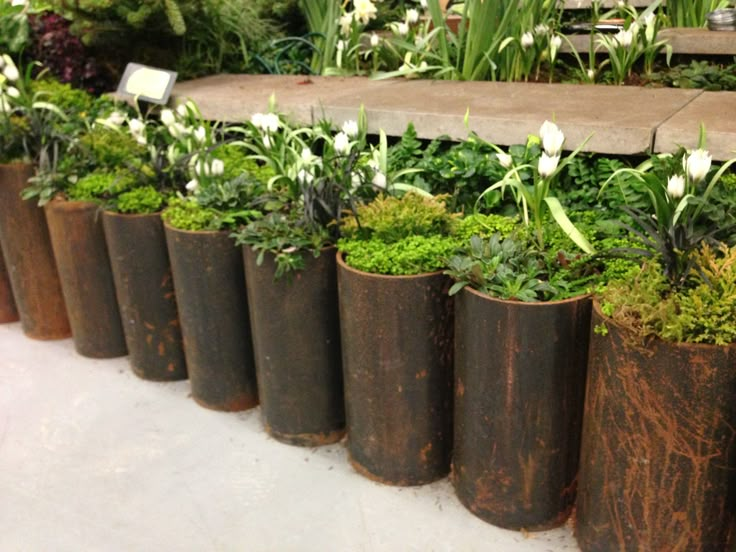
Defined edges make a noticeable difference, and raised planter borders offer both clarity and depth to compact gardens. Whether crafted from stone, wood, or corten steel, these borders help organize plant zones while minimizing soil spillover. They bring elevation into flat layouts, making each section feel curated rather than crowded. The added height also improves accessibility, which is particularly helpful for older gardeners or those with mobility concerns. When staggered in height or length, these planters create visual rhythm and guide the eye through tight spaces. Consider combining herbs, ornamental grasses, and trailing florals for a layered, textured effect. Raised beds warm faster in spring, extending the growing season for vegetables or seasonal blooms. They also improve drainage, protecting roots from rot in wetter climates. For extra impact, line the edge with pathway stones or mulch, framing each bed with crisp definition. This technique prevents compaction and makes weeding easier by isolating the soil zones. Ideal for patios, balconies, or narrow strips, these borders keep design grounded and intentional. They transform utilitarian planting into a structured visual feature, showcasing the best of tidy, small-space gardening without feeling rigid or overbuilt.
Bright White Patio Slabs to Lighten the Space
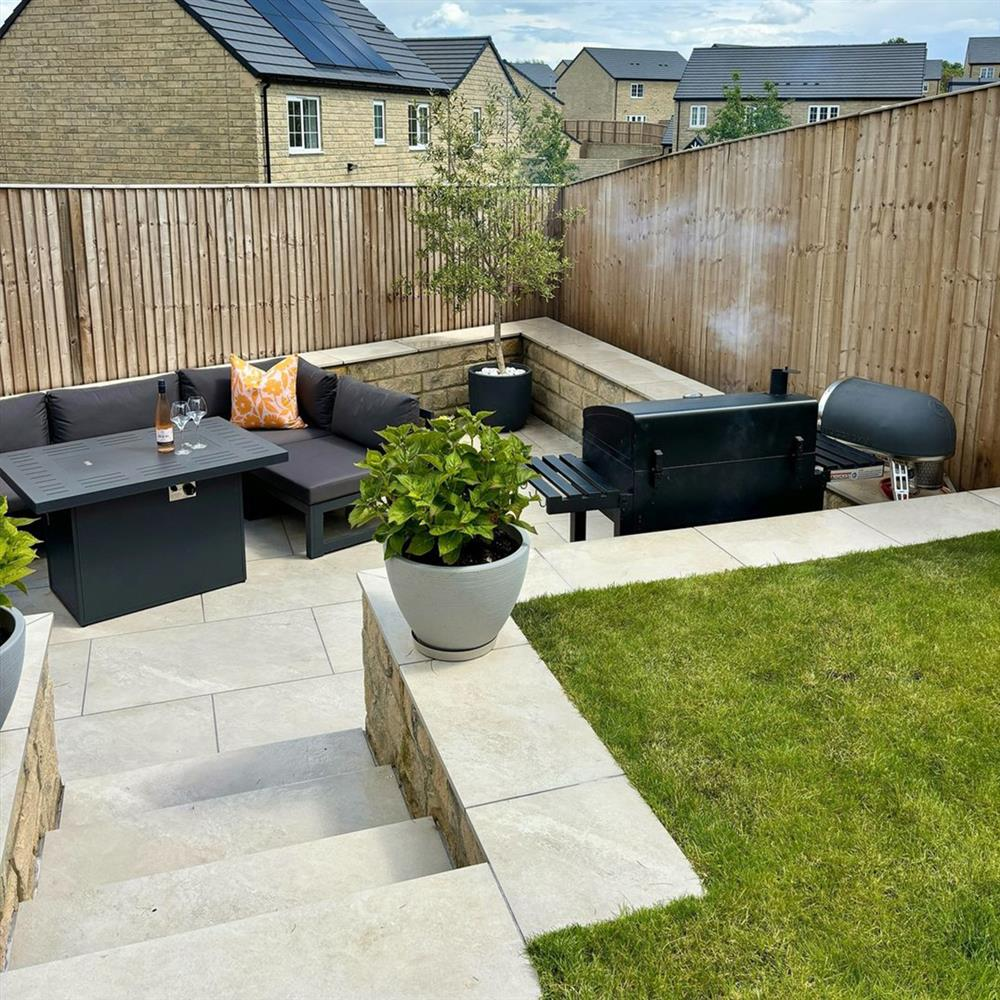
Crisp white patio slabs can instantly refresh a garden layout by brightening the ground plane and reflecting ambient light. Especially beneficial for shaded or north-facing areas, these pale surfaces amplify sunlight and counteract visual heaviness. Neutral stone types like white granite, porcelain, or light concrete work well, providing a sleek contrast to green foliage. Their clean palette allows colorful planters or bold furniture to pop without clashing. Large-format slabs reduce grout lines, lending a seamless, spacious feel even in tight quarters. To maintain brightness, choose anti-slip finishes or textured surfaces that resist staining and moss growth. Pairing white paving with dark edging or narrow plant borders adds definition without overcrowding. This design also suits minimalist styles, lending itself to both modern and rustic garden aesthetics. Drainage should be carefully planned to prevent pooling, especially on flat terrain. Interspersing potted greenery or decorative gravel between slabs breaks monotony and introduces a layered look. Light-reflecting surfaces are especially valuable in small gardens where sunlight is limited, making the space feel airier and more expansive. When applied strategically, white patio slabs act as visual amplifiers, breathing openness and cohesion into compact outdoor zones without requiring major restructuring.
Hanging Baskets & Ladder Planters

Layering elevation into a small garden is simple and striking with hanging baskets and ladder-style planters. These solutions harness unused vertical airspace, bringing texture, color, and greenery upward rather than out. Hanging baskets brimming with trailing petunias, ferns, or sweet potato vines soften overhead structures or porch eaves. Ladder planters provide a staggered planting canvas ideal for herbs, succulents, or compact annuals. Both options work well in tight layouts or urban balconies where ground space is precious. Painted or natural wood ladders add rustic charm, while black metal finishes lend a more industrial feel. Drainage is critical—liners and trays should be included to avoid overwatering and mess. Positioning these planters along walls or fences enhances privacy while boosting greenery. They’re easily movable, offering seasonal flexibility and quick garden refreshes without digging or heavy lifting. Light conditions can be customized by adjusting height or basket type, making them practical for partial-shade environments. These vertical accents introduce motion, soften hard lines, and bring balance to confined areas. Ideal for renters or those experimenting with small-scale gardening, this approach delivers maximum impact using minimal square footage. It’s a smart aesthetic and botanical choice for thriving in limited outdoor settings.
Mini Water Feature as a Focal Point

Soothing movement and reflective light can transform even the smallest garden, which is why a mini water feature proves invaluable in tight layouts. Whether it’s a tabletop fountain, a narrow rill, or a ceramic bubbling pot, these elements provide both sound and serenity. Small-scale water features are easy to install and maintain, often powered by compact solar pumps or low-voltage setups. They can be nestled among low-growing plants or set into raised beds for added elevation and visibility. The gentle trickle of water masks neighborhood noise and attracts birds, adding to the sensory richness of the space. Material choices like stone, glazed ceramic, or weathered metal offer stylistic flexibility, from modern to cottage aesthetics. For safety, especially in family settings, shallow and self-contained features are ideal. Placement is key—tuck the feature where it catches light but avoids full sun to reduce algae buildup. Surround it with pebbles or moss to complete the scene naturally. These focal points introduce tranquility while visually anchoring small gardens, helping define zones without heavy structural changes. More than decorative, water elements enhance ambiance and contribute to microclimate health, making them indispensable in creating serene, multi-sensory outdoor experiences.
Mixed‑Material Hardscape Zones

Blending textures and tones with a mix of hardscape materials brings dimension to small gardens without overwhelming them. Alternating between gravel, stone pavers, wood decking, and concrete pads can visually separate areas while preserving flow. This tactic helps guide movement and subtly designate functions—like a lounging nook versus a planting zone—without bulky dividers. Contrasts between warm-toned wood and cool gray stone add richness, while permeable surfaces such as decomposed granite aid in drainage and sustainability. For tight areas, irregular-shaped paths or asymmetrical layouts make the design feel more organic and less confined. Edging each material transition with narrow planting strips or LED strip lighting elevates the visual appeal. This approach also allows seasonal flexibility; lightweight gravel can be swapped out easily or paired with new accents. The interplay of surface texture enhances the sensory experience and draws attention to overlooked pockets of space. It’s a refined solution for homeowners who want curated variety within confined parameters. When executed well, mixed-material layouts ensure the garden feels layered, intentional, and dynamic—an environment that shifts subtly in mood from one corner to the next without losing cohesion or comfort.
Pollinator‑Friendly Wildflower Patch

Biodiversity thrives when gardens welcome native blooms and beneficial insects, which is why wildflower patches deserve a prominent role in compact layouts. Even a small area transformed into a pollinator-friendly haven can make a meaningful impact. Selecting a mix of native perennials—such as coneflowers, black-eyed Susans, bee balm, or milkweed—ensures seasonal coverage and supports vital bee and butterfly populations. These flowers require minimal care once established, thriving in well-draining soil with full sun. Cluster planting increases visibility to pollinators and enhances color saturation. Raised or bordered beds help contain the patch and define its space within the broader layout. To avoid visual chaos, limit the palette to 3–5 key bloom types and intersperse with ornamental grasses for balance. Deadheading selectively can prolong flowering and encourage regrowth. Water sparingly; most native wildflowers are drought-tolerant. This feature doesn’t only serve nature—it introduces gentle movement, vibrant hues, and rich textures into compact gardens. Educating guests or children about each plant’s ecological role adds another layer of value. Ultimately, these patches bring beauty and sustainability together, offering a living connection to local ecosystems and a peaceful burst of color that evolves throughout the seasons.
Lollipop Potted Roses for Vertical Height
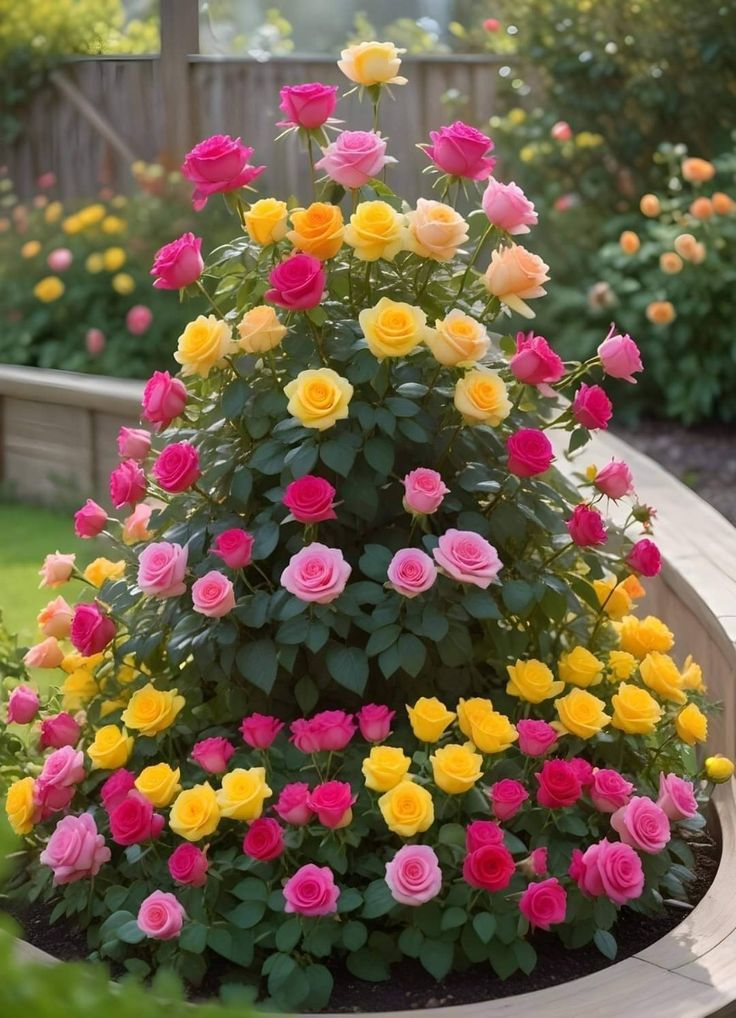
Lollipop-shaped rose standards add elegance and vertical structure to small gardens without demanding excessive ground space. These topiary-style potted roses feature a tall single stem topped with a rounded canopy of blooms, making them ideal for pathways, corners, or as focal points. Available in varieties like Floribunda or Hybrid Tea, they provide long-lasting color and fragrance from spring through fall. Planted in raised beds or decorative urns, they gain additional height and visibility, drawing the eye upward and creating layers of visual interest. Their upright form complements cascading or ground-hugging plants nearby, enhancing contrast. Regular pruning keeps the shape tight, while slow-release fertilizer encourages repeat flowering. Placement benefits from full sun and well-draining soil, with occasional support staking during windier seasons. Color themes can be coordinated—pair pastel roses with silvery foliage for a romantic palette or opt for reds with dark mulch for bold contrast. These roses not only elevate the aesthetic but also serve as architectural accents in tight layouts. Ideal for courtyards, patios, or entryway gardens, lollipop roses provide height without clutter, showcasing nature’s elegance in compact, thoughtfully designed arrangements.
Mini Potager with Compact Veggie Beds
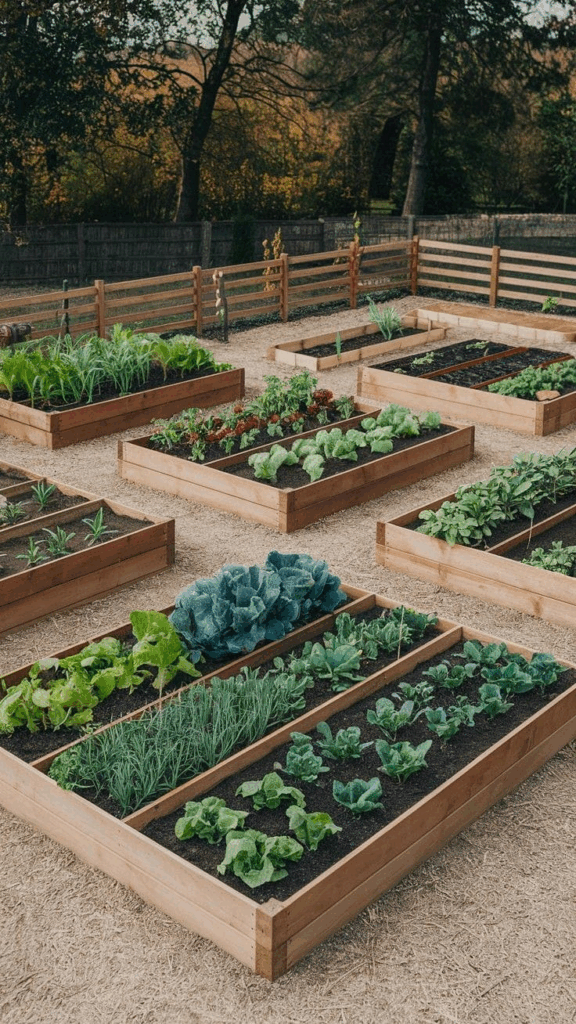
Productive and ornamental, a mini potager garden merges beauty with function in small yards. Designed for high yield and visual symmetry, this layout features compact veggie beds framed by herbs and edible flowers. Raised wooden boxes or stone-bordered beds provide structure and define pathways while keeping soil rich and contained. Leafy greens, root crops, and cherry tomatoes grow well in confined plots, especially when rotated seasonally for soil health. Bordering with calendula, nasturtium, or marigolds deters pests and adds vibrant pops of color. Smart placement—aligning taller crops at the rear and shorter ones upfront—ensures even sun exposure and easy access. Drip irrigation or soaker hoses simplify upkeep while keeping foliage dry and disease-free. Even in 4×4 or 6×6 ft layouts, thoughtful spacing can yield impressive harvests. A vertical trellis at the back of the bed maximizes space for beans or cucumbers. Paver paths between sections keep things tidy and prevent soil compaction. This garden type fosters a hands-on, seasonal rhythm while encouraging sustainable practices. For homeowners valuing both food and flair, a mini potager transforms a basic plot into an organized, edible sanctuary rich in utility and beauty.
Smart Lighting + Fairy Lights in Green Canopy
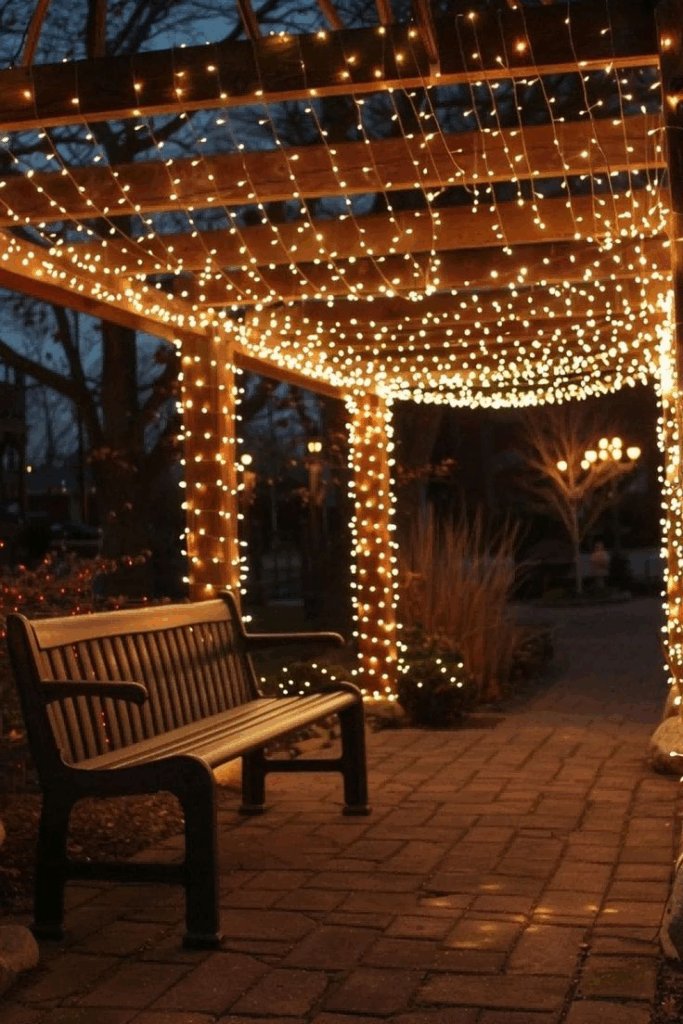
Tiny gardens come alive at night with thoughtfully layered lighting, especially under leafy canopies. Solar-powered fairy lights draped through trees or pergolas cast a soft, dappled glow perfect for evening ambiance. Pair them with strategically placed smart LED spotlights or motion-triggered path lights to enhance safety and highlight focal features. Battery-operated lanterns on shelves or hanging hooks contribute to a cozy, flickering atmosphere without overwhelming brightness. Smart timers allow automated operation, ensuring energy efficiency while maintaining mood. Dimmable options give flexibility depending on occasion—low light for relaxation or brighter tones for dining al fresco. For larger trees or pergolas, curtain-style string lights provide full canopy coverage and visual depth. Avoid harsh floodlights that disrupt the natural tone; instead, lean into warmth and subtle highlights. Lighting at varying heights—ground, mid-level, and overhead—ensures balanced illumination that feels intentional. Integrating lighting into plant beds or climbing trellises conceals the fixtures while enhancing visual interest. This lighting approach doesn’t just beautify—it enables year-round usability, safety, and atmospheric charm. When curated with restraint and vision, light becomes a design element as important as any hardscape or plant, redefining small gardens as spaces to savor even after sunset.
